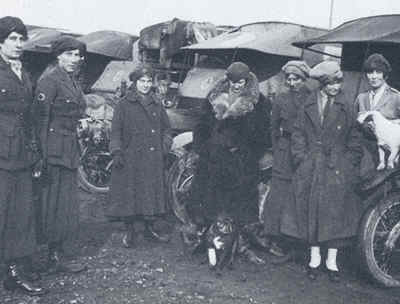The First Battle of the Marne
The First Battle of the Marne was fought in September 1914. By September 12th, the end of the Battle of the Marne, the war of movement seen since August 1914 had gone and the trench warfare associated with World War One had come into being.

How the French celebrated the First Battle of Marne
When Germany invaded Belgium on August 3rd 1914, their movement across Western Europe was swift and in accordance with the Schlieffen Plan. The Belgium army was swept aside with relative ease and the British Expeditionary Army (BEF) had retreated at the Battle of Mons. General French had wanted the BEF to withdraw to the coast but this had been forbidden by Lord Kitchener who ordered that the BEF should not separate itself from the French army. The French army retreated towards the River Marne and it was here that both German and French armies fought out the first major battle on the Western Front.
The German advance got them as near as 30 miles to Paris. The French capital got itself ready for a siege and the French government left the capital for the safety of Bordeaux.
The French army under the command of Joseph Joffre reached an area to the south of the River Marne. For nearly a fortnight the French army had been on the retreat and many feared that it was not in a fit enough state to fight the seemingly invincible and constantly advancing German army.
Joffre decided that the best form of defence was to attack. Joffre ordered an attack on the German First Army. On September 6th, 150,000 French soldiers of the Sixth Army attacked the right flank of the German army. The Germans had to face up this attack and as a result a sizeable split occurred in the whole German army attacking Paris as the German First Army had to redirect its attention towards the French Sixth Army. This gap, of about 45 kilometres, was exploited by the BEF and the French Fifth Army. However, the momentum of attack lay with the Germans and the Sixth Army, led by Maunoury, faced almost certain defeat had it not been helped by 6,000 infantry reservists who were transported out to the battlefield in taxi cabs!
On September 6th, the French army managed to increase the gap between the German First and Second Armies. This further hampered communications for the Germans. This meant that the senior officers commanding the German attack got confusing messages about what was going on in the actual battle zone.
Von Moltke, the German Chief of Staff, feared that the Allies, rather than simply driving a gap between two of his armies, were in a position whereby they could not only halt the German advance but defeat the German armies involved in the attack on Paris. Because of this communication breakdown, on September 9th, von Moltke ordered his armies to retreat and they withdrew to an area near the River Aisne. Here the Germans dug in and dug trenches. Little would they have guessed that these trenches were to dominate the war for several years to come.
The Battle of the Marne was very costly in terms of casualties. In fact, it was a precursor of what was to come. Some 250,000 French soldiers were lost and the Germans suffered about the same casualties. The BEF lost just under 13,000 men. However, Paris was saved and the Germans expected outcome of the Schlieffen Plan had faltered. Now years of trench warfare was to dominate the Western Front.Why did the Germans resort to digging trenches especially as they had not been trained in the ‘art’ of trench warfare in the lead up to the attack on Belgium? The Schlieffen Plan had been a plan of attack that did not cater for either defeat or retreat. Therefore the German High Command had not planned for anything like what might happen if the French fought back. Hence when the German army had retreated forty miles from the Marne, it had no other plan than to dig in and wait for the advancing Allied army.
Related Posts
- The Battle of Mons was the first major battle of World War One. Mons was a battle of movement unlike the battles that followed which…
- Germany’s plan for her attack on Western Europe in May 1940 was based entirely on blitzkrieg. Germany’s plan was to avoid a frontal assault on…
- The Second Battle of the Aisne was the main part of the Nivelle Offensive of April 1917. Robert Nivelle’s plan was for a huge attack…